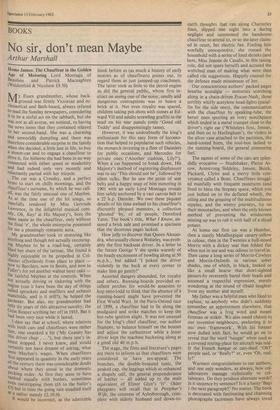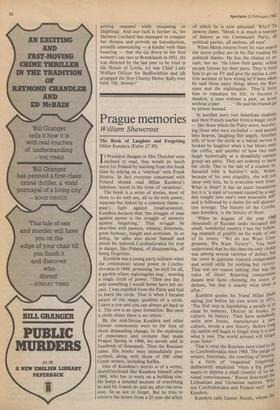BOOKS
No sir, don't mean Maybe
Arthur Marshall
Home James• The Chauffeur in the Golden Age of Motoring Lord Montagu of Beaulieu and Patrick Macnagh ten (Weidenfeld & Nicolson £9.50) Beaulieu and Patrick Macnagh ten (Weidenfeld & Nicolson £9.50)
My Essex grandmother, whose back- ground was firmly Victorian and ec- clesiastical and Bath-based, always refused to read the Sunday newspapers, considering it to be a sinful act on the sabbath, but she was not at all averse, we noticed, to having the news items that they contained relayed to her second-hand. She was a charming and unworldly dumpling and there was therefore considerable surprise in the family when she decided, a little late in life, to buy a motor-car and to engage a chauffeur to drive it, for hitherto she had been in no way connected with either speed or modernity and had indeed only very recently and reluctantly parted with her tricycle. The car was a Crossley, and a perfect brute to start on chilly mornings, and the chauffeur's surname, by which he was call- ed, was the fairly unusual one of Maybee. As at the time one of the hit songs, so tunefully rendered by Miss Gertrude Lawrence, in the delightful musical com- edy, Oh, Kay! at His Majesty's, bore the same name as the chauffeur, only without the final 'e', the whole enterprise possessed for me a pleasingly romantic aura.
My grandmother' took to motoring like anything and though not actually encourag- ing Maybee to be a road-hog, certainly liked her share of the tarmac. She found it highly enjoyable to be propelled in Col- chester effortlessly from place to place now to Barclays, now to Boots, and now to Fuller's for yet another walnut layer cake the faithful Maybee at the controls. When not actually driving or tinkering with the engine (can it have been the day of things Called sprockets and mufflers and exhaust inanifolds, and is it still?), he helped the gardener. But alas, my grandmother had Only six years of this attractive novelty, the Grim Reaper scything her off in 1933. But it had been very nice while it lasted. I dare say that at school, where relatives with both cars and chauffeurs were rather rare, one swanked a bit (`My Granny has this driver chap . . .'), but there one's in- terest stopped. I never knew, and would certainly not have dreamt of asking, what Were Maybee's wages. When chauffeurs first appeared in quantity in the early years of the century there was considerable doubt about where they stood in the domestic Pecking order. At first they seem to have ranked equally with butlers, sometimes even outstripping them (£6 to the butler's 5) but in time the going rate steadied itself at a rather measly £2.10.0).
It would be incorrect, as the admirable
book before us (as much a history of early motors as of chauffeurs) points out, to regard them as just jumped-up coachmen. The latter took as little to the petrol engine as did the general public, whose first in- stinct on seeing one of the noisy, smelly and dangerous contraptions was to heave a brick at it. Not even royalty was spared, children taking pot-shots with stones at Ed- ward VII and adults scrawling graffiti in the mud on his rear panels (only 'Good old Teddy' and disappointingly tame).
However, it was undoubtedly the king's enthusiasm for this easy form of locomo- tion that helped to popularise such vehicles, the monarch investing in a fleet of Daimlers for public occasions, and Mercedes for private ones (`Another cushion, Lily?'). When a car happened to break down, His Majesty's method of registering displeasure was to say 'This should not be', followed by silent sulks. But he saw the point of seat belts and a happy snap of him motoring in 1901 with an early Lord Montagu reveals him safely anchored by a vast canvas belt to a 22 h.p. Daimler. We owe these piquant details of his time awheel to his chauffeur's discreetly phrased memoirs, a collection `ghosted' by, of all people, Dornford Yates. The book's title, What I Know, en- sured a brisk sale and promised a spiciness that the decorous pages lacked.
How jolly to discover that Queen Alexan- dra, who usually chose a Wolseley, was prob- ably the first backseat driver. In a letter to the future George V she spoke warmly of the heady excitement of bowling along at 50 m.p.h., but added 'I poked the driver violently in the back at every corner to make him go gently!'
Assorted dangers abounded, for royalty and others. Running-boards provided ex- cellent perches for would-be assassins to hop onto (odd to think that the absence of a running-board might have prevented the First World War). In the Paris-Ostend race of 1899, a chauffeur had to lie along the mudguard and strike matches to keep the hot-tube ignition alight. It was not unusual for the king's chief chauffeur, our author Stamper, to balance himself on the bonnet and adjust the carburettor while a lesser driver kept the machine bucketing along at / a good old 40 m.p.h.
The stage, the films and literature's pages are there to inform us that chauffeurs were considered to have sex-appeal. The breeches, the double-breasted tunic, the peaked cap, the leggings which so enhanced a shapely calf, the general preponderance of leather — all added up to the male equivalent of Elinor Glyn's 'It'. Older playgoers will recall that in Potiphar's Wife, the countess of Aylesborough, com- plete with elderly husband and down-to-
earth thoughts that ran along Chatterley lines, slipped one night into a daring negligee and summoned the handsome chauffeur to attend to, or so she later claim- ed in court, her electric fan. Finding him woefully unresponsive, she roused the household with a series of loud shrieks (and here, Miss Jeanne de Casalis, in this taxing role, did not spare herself) and accused the wretched man of making what were then called vile suggestions. Happily counsel for the defence made mincemeat of her.
Our conscientious authors° packed pages breathe nostalgia — motorists scorching along in a chain-driven Frazer-Nash, those terribly whiffy acetylene head-lights (paraf- fin for the side ones), the communication with the chauffetir by speaking-tube, the better ones sporting an ivory mouthpiece which ended in a metal trumpet close to the driver's right ear ('Whiteleys first, Jenner, and then on to Hurlingham'), the violets in the silver vase attached to the partition, the hand-tooted horn, the tool-box lashed to the running-board, the general pioneering feel.
The names of some of the cars are splen- didly evocative — Studebaker, Pierce Ar- row, Armstrong Siddeley, Jensen, Buick, Packard, Clyno and a merry little con- veyance called a Bean. Chauffeurs struggl- ed manfully with frequent punctures (and lived to bless the Stepney spare, which you just bolted on to the deflated wheel), the oiling and the greasing of the multitudinous nipples, and the wintry journeys, ice on their moustaches, and when the only known method of preventing the windscreen misting up was to rub it with half of a sliced potato.
At home our first car was a Humber, then a stately Metallurgique canary-yellow in colour, then in the Twenties a bull-nosed Morris with a dickey seat that folded flat when not in use and was odious to travel in. Then came a long series of Morris-Cowleys and Morris-Oxfords in various sober shades, one of which, in black, looked so like a small hearse that short-sighted passers-by reverently bared their heads and assumed a respectful expression, merely wondering at the sound of ribald laughter from my mother and myself.
My father was a helpful man who liked to explain, to anybody who didn't suddenly remember an appointment elsewhere, that chauffeur was a frog word and meant fireman or stoker. We also owed chassis to our inventive neighbours, preferring it to Our own 'framework'. With his listener now dulled with fact, he would go on to reveal that the word 'hangar' when used as a covered resting-place for aircraft was real- ly the French hangar or cart-shed. `Oh?' people said, or 'Really?' or, even 'Oh, real- ly?'
Warmest congratulations to our authors, and one only wonders, as always, how col- laborators manage stylistically to col- laborate. Do they produce alternate words? Is it sentence by sentence? Is it a hasty 'Bags I the next paragraph?' No matter. The book is decorated with fascinating and charming photographs (actresses have always loved getting snapped while mounting or alighting). And our luck is further in, for Barbara Cartland has managed to conquer her shyness and provide an Introduction, proudly announcing — a kinder verb than boasting — that she (a) drove in the first women's car race at Brooklands in 1931, (b) was directed by the last peer to be tried in the House of Lords, (c) was Chief Lady Welfare Officer for Bedfordshire and (d) arranged the first Charity Motor Rally ever held. Oh, hooray!











































 Previous page
Previous page